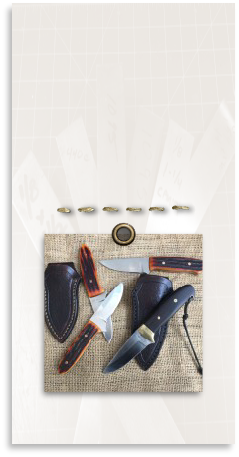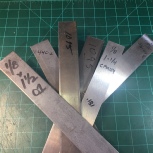



I love feed back on my knives, so if you have any comments or suggestions feel free to pass them along. If you have any photos of you and the knife you purchased send them along also... especially field photos. Thanks



















The articles below are From Wikipedia, the free encyclopedia
KNIFE STEEL
Steel Alloy Steels
Alloy steel
5160, Spring steel. Popular forging steel for swords and large knives. High toughness and good wear resistance. 5160 spring steel is mainly used on Medieval type swords.[3]
Tool steels
Tool steel grades used in cutlery : A, D, O, M, T, S, L, W. See also AISI Tool Steel Grades.
The following are tool steels, which are alloy steels commonly used to produce hardened cutting tools:
A2, a steel that trades wear resistance for toughness. It is used in custom made fighting knives
D2, has a high chrome content of 12.00%, it is called "semi-
O1, popular forging steel. Good wear resistance and edge stability. Relatively tough, but not as much as A2 or 5160.[8] It is most commonly used by Randall Knives, Mad Dog Knives,[9] and many other custom knife makers.
M2, slightly tougher than D-
W1, water hardening tool steel. High carbon content.[1]
W2, a tool steel that holds its edge quite well but not very tough. Has a carbon content of 1.5.[1] Most readily available W2 has a carbon content of no more than 1-
CPM Series
Crucible Industries[13] produces Crucible Particle Metallurgy (CPM) tool steels using a powder metal forge process.[14]
CPM 1V,[15] proprietary steel, very high toughness, several times higher than A2 with same level of wear resistance.[1]
CPM 3V,[16] proprietary steel, very high toughness, less than CPM 1V, but more than A2, and high wear resistance, better than CPM 1V. Used by several custom knives makers and factories, including Jerry Hossom, Reese Weiland. Makes good choice for swords and large knives.[1]
CPM 4V,[17] high impact toughness and a very good wear resistance.
CPM 9V,[18] modification of CPM 10V with lower carbon and vanadium to improve toughness and heat check resistance.
CPM 10V (AISI A11),[19] highly wear-
CPM 15V,[20] proprietary, extremely high wear-
Chrome steel
Chrome steel is one of a class of non stainless steels which are used for applications such as bearings, tools and drills.
AISI 52100, ball bearing steel. In terms of wear resistance, a little better than that of the O1 steel, however 52100 is also tougher. It has very fine carbides, which translates into high edge stability. Used by many custom makers, Swamp Rat knives uses 52100 steel under the name SR101.[1] Also referred to as 100 Cr 6/102 Cr6 as per ISO nomenclature and confrorms to BS grade En31.
SUJ2, Japanese equivalent to AISI 52100 steel.
DIN 5401
Semi-
Steels that did not fit into the stainless category because they may not have enough of a certain element, such as chromium.
V-
V-
V-
Stainless steel
Stainless steel is a popular class of material for knife blades because it resists corrosion and is easy to maintain. However, it is not impervious to corrosion or rust. In order for a steel to be considered stainless it must have a chromium content of at least 13%.[21]
The principle of stainless steel is that in an oxidizing chemical environment the oxide (chromium and sometimes nickel and other metal oxides) is stable, and when in a reducing (shortage of oxygen) environment at least one metal is stable. This usually works, except in an acid environment. In order to be hardenable, knife steel can contain limited chromium and very little nickel. So, even though stainless, hard knife steel has limited resistance to corrosion.
Austenitic stainless retains its non-
154CM/ATS-
These two steels are practically identical in composition.[22] They were introduced into custom knives by Bob Loveless circa 1972.
154CM[23] is produced by Crucible Industries.[13] It is used extensively by Benchmade Knife Company.
CPM 154 is identical to 154CM in composition, produced using CPM Process,[14] with all the benefits of the CPM technology.[8][24]
ATS-
The latter two are considered premium cutlery steels for both folding knives and fixed blades.[8]
300 series
American stainless steel manufactured by Allegheny Ludlum steel Co and Crucible Industries.[13]
302 is a Chromium-
303 is a non-
303 SE is a non-
304L is a non-
316L is a non-
321 is a non-
400 series
The 400 series remains one of the most popular choices for knife makers because it is easy to sharpen and it is resistant to corrosion.
410 is a hardenable, straight-
416 is very similar to 410 with the addition of sulfur to improve machinability.
420 has more carbon than 410, but less than 440. As such it is softer than 440, but has a higher toughness.[30]
420 series contain 4 types, which is defined by its carbon content. 420A / 1.4021, 420B / 1.4024, 420C / 1.4034, and 420D / 1.4037. 420D stainless steel has about 0.66 carbon content, this steel grade is widely used to make high end razor blades, surgical scalpels etc. It obtains about 57 HRC after suitable heat treatment. 420HC ( 420C ) is a higher carbon content 420 stainless. The HC stands for "high carbon" and it can be brought to a higher hardness than 420 and should not be mistaken for it. Buck Knives uses 420HC extensively.[8] 420A ( 420J1 ) and 420B ( 420J2 ) are economical, highly corrosion resistant stainless steel grades. Knife manufacturers use this material in budget knives, also in diving knives due to its high resistance to corrosion.[8]
440 series has three types, 440A, 440B and 440C. 440A is a relatively a low cost, highly corrosion resistant stainless steel. In China, Ahonest ChangJiang Stainless steel developed 440A modified 7Cr17MoV, by adding more element vanadium.[31] 440B is almost identical to 440A, but has a higher carbon content range compared to 440A[31] 440C is considered a high-
AUS series
The AUS stainless steel series is produced by Aichi Steel Corporation, Japan. They differ from the AISI 4xx series because they have vanadium added to them. Vanadium improves the wear resistance, toughness, and ease of sharpening.[8] In the alloy name the appended 'A' indicates the alloy has been annealed.
AUS-
AUS-
AUS-
CPM SxxV series
The SxxV series are Crucible Industries[13] stainless steels produced using CPM process.[14]
CPM S30V,[32] on the lower end of the SxxV steels, it has a carbon content of 1.45%. However, S30V is still considered to be a superior choice for knife making. CPM S30V is used in a wide range of ZT knives.[33][34]
CPM S35VN[35] is a martensitic stainless steel designed to offer improved toughness over CPM S30V. It is also easier to machine and polish than CPM S30V. It is used in many high end kitchen knives including those by New West Knifemakers[36]
CPM S60V (formerly CPM T440V) (discontinued), very rich in vanadium. CPM S60V has a carbon content of 2.15%.[8] It was an uncommon steel, but both Spyderco and Kershaw Knives offered knives of this steel, Boker still offers folders made from CPM S60V.[37]
CPM S90V (formerly CPM T420V)[38] has less chromium than S60V, but has almost twice as much vanadium.[8] S90V's carbon content is also higher, resting around 2.30%.
CPM S110V[39] has higher corrosion resistance than S90V and marginally better wear resistance. The additional corrosion resistance while retaining all the benefits of S90V makes this steel extremely desired for kitchen cutlery.[40]
CPM S125V, online information is not available as of August 2014, contact Crucible Industries sales[41] for information. It contains 3.25% carbon, 14% chromium and 12% Vanadium and other alloying elements.[1] Exceptionally high wear resistance, making it difficult to process and machine for knifemakers. At first only used in custom knives, it has been utilized by larger manufacturers more recently in limited quantities.
VG series
Japanese stainless steels, manufactured by Takefu Special Steel.[42]
VG-
VG-
VG-
VG-
VG-
San-
Due to small Vanadium content VG-
CTS series
American stainless steels produced by Carpenter Technology using vacuum melt technology.
CTS-
CTS-
CTS-
CTS-
CTS-
CTS-
Mo/MoV series
Chinese and American stainless steels; the manufacturers are unknown with the exception of 14-
(sorted by first number.)
14-
2Cr13, belongs to 420 grade series, very basic. EN 1.4021 / DIN X20Cr13, widely used in economic cutting tools, 50HRC max after heat treatment.
3Cr13, in 420 grade series, it contains 420A 420B 420C 420D. 3Cr13 steel is 420B, EN 1.4028 / DIN X30Cr13, 52HRC Approx after heat treatment.
3CR13MoV, made by adding more elements molybdenum and vanadium to the 420J2-
4Cr13, EN 1.4034 / DIN X46Cr13, 420C stainless steel, it obtains about 55-
4Cr13Mo, EN 1.4419 / DIN X38CrMo14, developed based on GB 4Cr13 / DIN X46Cr13 by adding elements Molybdenum.
4Cr14MoV, EN 1.4117 / DIN X38CrMoV15, good enough to make kitchen knives.
5Cr15MoV, Some knives manufacturers define as 5Cr13MoV, the hardness could be 55-
6CR13MoV, It's also wrote as 6Cr14MoV. The Patented name applied by Ahonest Changjiang Stainless steel Co.,Ltd. Similar stainless steel grade 6Cr14 ( 6Cr13 ) / 420D which does not contain molybdenum and vanadium is superior to make razor blades, surgical scalpels etc.
7CR17MoV, it's 440A modified which contains more elements vanadium, the benefits of Vanadium (V) • Increases strength, wear resistance, and increases toughness
the recommended hardness about 55/57 HRC.
8CR13MoV & 8CR14MoV, actually these grades do not have very big difference. They are similar to AICHI AUS-
9Cr13MoVCo ( 9Cr13CoMoV ), produced by Ahonest Changjiang stainless steel, described as forged high carbon cobalt stainless steel, uses include high end barber scissors, hunting knives etc.
9Cr18MoV, 440B modified, a higher end Chinese stainless steel used mostly in high-
Sandvik series[43]
6C27, A common knife steel grade with good corrosion resistance and low hardness, mainly used in applications where the need for wear resistance is low.
7C27Mo2 Generally the same properties as Sandvik 6C27, but with improved corrosion resistance.
12C27, A grade with high hardness and good wear resistance. Takes very keen edge with ok edge holding.
12C27M, Another Swedish stainless razor steel. A very pure, fine grained alloy. A grade with good wear resistance and good corrosion resistance, well suited for the manufacture of kitchen tools.
13C26, Also known as a Swedish stainless razor steel. Generally the same properties as Sandvik 12C27, but with slightly higher hardness but less corrosion resistant. The Swedish steel maker Uddeholm AB also makes a virtually identical razor steel composition known as AEB-
14C28N, was designed by Sandvik at Kershaw's behest to have the edge properties of 13C26 but with increased corrosion resistance by adding nitrogen and chromium. Available in Kershaw knives (as of 2012) and in other brands.
M390 -
CPM-
Several steel alloys have carbon amount close or above 3%. As usual those steels can be hardened to extremely high levels, 65-
ZDP-
Elmax, produced by Bohler-
Stain-
The steels in this category have much higher resistance to elements and corrosion than conventional stainless steels. They are used in knives designed for use in aggressive, highly corrosive environments, such as saltwater, areas with high humidity like tropical forests, swamps, etc.[56][dubious – discuss]
H1, produced by Myodo Metals, Japan. Used by Spyderco in their salt water/diving knives. Benchmade used it as well, later replaced with X15TN.[1]
X15Tn, French steel, originally designed for medical industry and jet ball bearings. Used by Benchmade in their salt water/diving knives.[1]
N680, Bohler-
N690CO an Austrian stainless steel hardened to the high Rc50 range. Currently found in Spyderco's Hossom knives and the recently discontinued Italian-
Carbon steel
Carbon steel is a popular choice for rough use knives. Carbon steel tends to be much tougher and much more durable, and easier to sharpen than stainless steel. They lack the chromium content of stainless steel, making them susceptible to corrosion.[8]
Carbon steels have less carbon than typical stainless steels do, but it is the main alloy element. They are more homogeneous than stainless and other high alloy steels, having carbide only in very small inclusions in the iron. The bulk material is harder than stainless, allowing them to hold a sharper and more acute edge without bending over in contact with hard materials. But they dull by abrasion quicker because they lack hard inclusions to take the friction. This also makes them quicker to sharpen. Carbon steel is well known to take a sharper edge than stainless.
10xx series
The 10xx series is the most popular choice for carbon steel used in knives. They are very durable.
1095, a popular high-
1084, carbon content 0.80-
1070, carbon content 0.65-
1060, used in swords. It has a carbon content of 0.55-
1055, used in swords and machetes often heat-
V-
V-
V-
Aogami/Blue-
a Japanese exotic, high-
Aogami/Blue-
Aogami/Blue-
Aogami/Blue-
Aogami/Super blue The same steel as Blue-
Shirogami/White-
Shirogami/White-
Shirogami/White-
Kigami/Yellow-
"Better" steel compared to SK series, but worse than both, Aogami and Shirogami. Used in high end tools and low/mid class kitchen knives.
Other proprietary steels
INFI, a unique steel used in Busse knives. It is a tough steel, that resists both wear and stains. It has a carbon content of 0.50%[8]
Blade materials are those used to make the blade of a knife or other simple edged hand tool or weapon, such as a hatchet or sword.
The blade of a knife can be made from a variety of materials, the most common being carbon steel, stainless steel, tool steel and alloy steel. Other less common materials used in knife blades include: cobalt and titanium alloys, ceramics, obsidian, and plastic.
The hardness of steel is usually stated as a number on the Rockwell C scale (HRC). The Rockwell scale is a hardness scale based on the resistance to indentation of a material, as opposed to other scales such as the Mohs scale (scratch resistance) testing used in mineralogy. As hardness increases, the blade becomes capable of taking and holding a better edge, but is more difficult to sharpen and more brittle (commonly called less "tough"). Laminating a harder steel between a softer one is an expensive process that to some extent gives the benefits of both.



-





